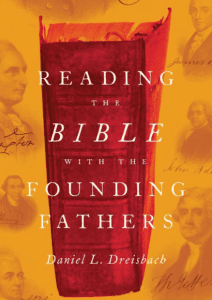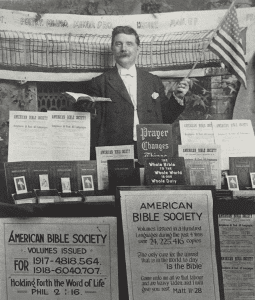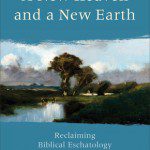 Ronald E. Osborn wraps up part one of his new book Death Before the Fall: Biblical Literalism and the Problem of Animal Suffering with a sketch of a new approach to hard questions of the Christian faith. He uses three different images to cast this vision.
Ronald E. Osborn wraps up part one of his new book Death Before the Fall: Biblical Literalism and the Problem of Animal Suffering with a sketch of a new approach to hard questions of the Christian faith. He uses three different images to cast this vision.
First, he suggests that the Supreme Court provides an approach we should consider. Every decision (or almost every decision) has a majority opinion and a dissenting opinion. The dissenting justices are not disloyal, they simply disagree about the application of constitutional law in this instance. Dissenting opinions sometimes (but not always) point to future directions in consensus. Osborn poses the question:
What if Christian colleges and universities – even those affiliated with traditions with highly literalistic doctrines of creation – embraced a picture of unity in the body of Christ that included the concept of necessary loyal dissent within a framework of basic respect, transparency, and honest searching for truth? (p. 114-115)
Of course, the idea of loyal dissent is deeply troubling to many Christians. Open dialogue carries with it the possibility that we have not yet arrived at the whole truth and that change is possible. After all, the foundation may begin to crack, and who knows what will happen next. Religion, at least “fundamentalist” religion is addicted to certainty. Rather than viewing statements of faith or other such documents as consensus subject to ongoing dialogue they are unquestionable dogmas separating the insider from the outsider.
 Earlier in the book Osborn introduced an analogy comparing the foundationalist approach common in many conservative evangelical or fundamentalists groups to a stacked brick tower. This is, he says, “another image that must be challenged with better pictures of the life of the mind.” (p. 115) The tower is, intrinsically and irreparably, a faulty tower. (The image to the right is from Wikipedia)
Earlier in the book Osborn introduced an analogy comparing the foundationalist approach common in many conservative evangelical or fundamentalists groups to a stacked brick tower. This is, he says, “another image that must be challenged with better pictures of the life of the mind.” (p. 115) The tower is, intrinsically and irreparably, a faulty tower. (The image to the right is from Wikipedia)
Loyal dissent only makes sense if we move from the image of a tower with indubitable facts on which all rests to more helpful distributed images of our understanding of Christian faith. Osborn begins with a discussion of critical realism. He quotes N. T. Wright from The New Testament and the People of God, and reflects on the quote:
“Every human community shares and cherishes certain assumptions, traditions, expectations, and anxieties, and so forth, which encourage its members to construe reality in particular ways, and which create contexts within which certain kinds of statements are perceived as making sense.” What all this means is that we must abandon any pretensions to absolute certainty about our interpretations and confess that we always see “through a glass darkly” (1 Cor. 13:12). This is certainly true in scientific matters, but is perhaps especially true in theological ones (it was, after all, theology and not science that Paul was speaking of when he used the “through a glass darkly” metaphor. (p. 119)
There is both a reality we strive to understand and a realization that do not have a complete and unbiased perspective.
 Nets and Boats not Towers. Osborn offers two images to counter the image of knowledge and Christian faith as a brick tower liable to fall if the wrong brick is removed. The first is the image of a net or web.
Nets and Boats not Towers. Osborn offers two images to counter the image of knowledge and Christian faith as a brick tower liable to fall if the wrong brick is removed. The first is the image of a net or web.
The strength or stability of a net does not depend upon any one of its nodes, but upon the entire field as a unified whole. We can alter or mend different cross-points in the net using a wide variety of “knots” (methods) without fear that doing so will cause the entire net to become unraveled. Net menders will not be overly troubled by the different readings of Genesis or other parts of Scripture as long as these readings preserve the overall coherence of the Christian narrative. … The nodes in the net of Christian truth – which include knowledge gleaned from tradition, reason, observation and Scripture – are mutually supportive and mutually defining, never standing alone the way foundation of a brick tower does. (p. 120)
The second image Osborn considers is that of a boat on a long voyage where repairs are continually made to keep the boat afloat. A plank here, a plank there, and paradoxically the boat is made anew in the process. The boat itself is what counts, not the individual planks that make up the boat.
[T]he ship is strong enough to continue sailing while some of its planks are being restored. Dynamic change requires the continuity and stability of the total system, while the stability of the total system requires constant dynamic change at the level of its constituent parts. (p.121)
No analogy is perfect, and all of these will breakdown at some point, but openness to loyal dissent, an image of knowledge and faith as a net rather than a tower, and the interplay of dynamic change and continuity as a normal process can all contribute to deep and lasting Christian faith and a stronger church.
What do you think of the images that Osborne introduces?
Is loyal dissent a positive rather than a negative?
Is the image of a net better than the image of a tower?
Is it possible to view Christian faith as something akin to a ship undergoing a constant dynamic change? What are the constraints on this change?
Osborn concludes this chapter setting up part two where he will explore the question of death before the fall and animal suffering:
I assume the overall coherence as well as the compatibility of scientific and theological frameworks, the postfoundationalist character of all knowledge, the need for intellectual openness to new insights from diverse sources, and the necessity of developing an understanding of animal suffering consistent with God’s character of love as revealed in the historical person of Christ. I believe that Christians can boldly pursue the doctrinal “net mending” or “ship building” in the light of challenging scientific evidence, since all truth is ultimately one. (p.121)
I think he is on to something important with this approach. Other approaches, where each plank of the ship is foundational as in the tower can leave people “clinging to a single board as their vessels break apart into so much driftwood on the high seas.”
If you wish to contact me directly you may do so at rjs4mail[at]att.net
If interested you can subscribe to a full text feed of my posts at Musings on Science and Theology.












